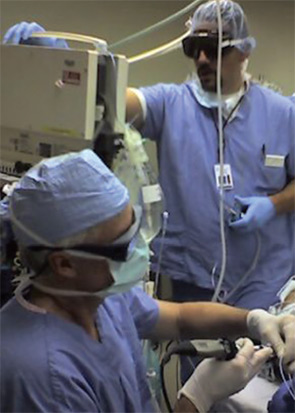After recognizing that it would be far better to have patients who required more than one specialist to be scheduled at the same time so that both doctors could plan on being there, they opened the airway clinic in 1998 and began seeing patients together routinely. For three years, a gastroenterology fellow worked there, too, making for a full aerodigestive team. The clinic is working on getting another gastroenterologist.
Explore This Issue
June 2010“I knew that I needed help managing the airway,” Dr. Elstad added. “The clinic has been excellent, I think, for the patients, first, and for us and for our training.”
The most common disorders treated at the clinic are idiopathic subglottic stenosis and post-intubation stenosis. The clinic also sees some adults with problems caused by congenital diseases as well as cases of tracheobronchomalacia, laryngeal paralysis, vocal fold paralysis and fixation and occasionally anastomotic stenosis in lung transplant patients.

Procedures
Many patients come to the clinic complaining of shortness of breath, and it’s not always because of an airway lesion, Dr. Smith said. That’s where the collaborative nature of the clinic is a plus, he said. “Other causes are important to recognize,” Dr. Smith said. “The benefit of having a physician with an internal medicine perspective to help assess these and manage them, in my view, is invaluable.”
In 2009, the clinic performed 14 open reconstructive procedures, 75 endoscopic procedures, 10 stent placements, nine intrabronchial valve replacements and 20 diagnostic bronchoscopies with sedation.
For evaluation, the clinic relies heavily on the laryngotracheobronchoscopy procedure, so much so that Dr. Smith called it “the diagnostic procedure that makes [the] airway clinic work.” The procedure, which accomplishes the assessment in almost all patients, is performed without sedation. No separate sedated bronchoscopy is needed, and the procedure helps with pre-surgical planning.
Dr. Smith noted that even though it’s crucial to know how to perform this procedure, he didn’t learn it in residency, but, rather, took a course at the American Academy of Otolaryngology-Head and Neck Surgery meeting at COSM.
Dr. Elstad said that about 60 percent of the bronchoscopies performed at the clinic are for evaluation and diagnosis, while about 40 percent are for treatment. The speed of the procedure is a big advantage. “One of the real benefits of having this clinic is that outpatient flexible bronchoscopies are performed in minutes rather than what essentially takes two hours,” he said. “It’s very efficient for evaluating the airways.”
Leave a Reply